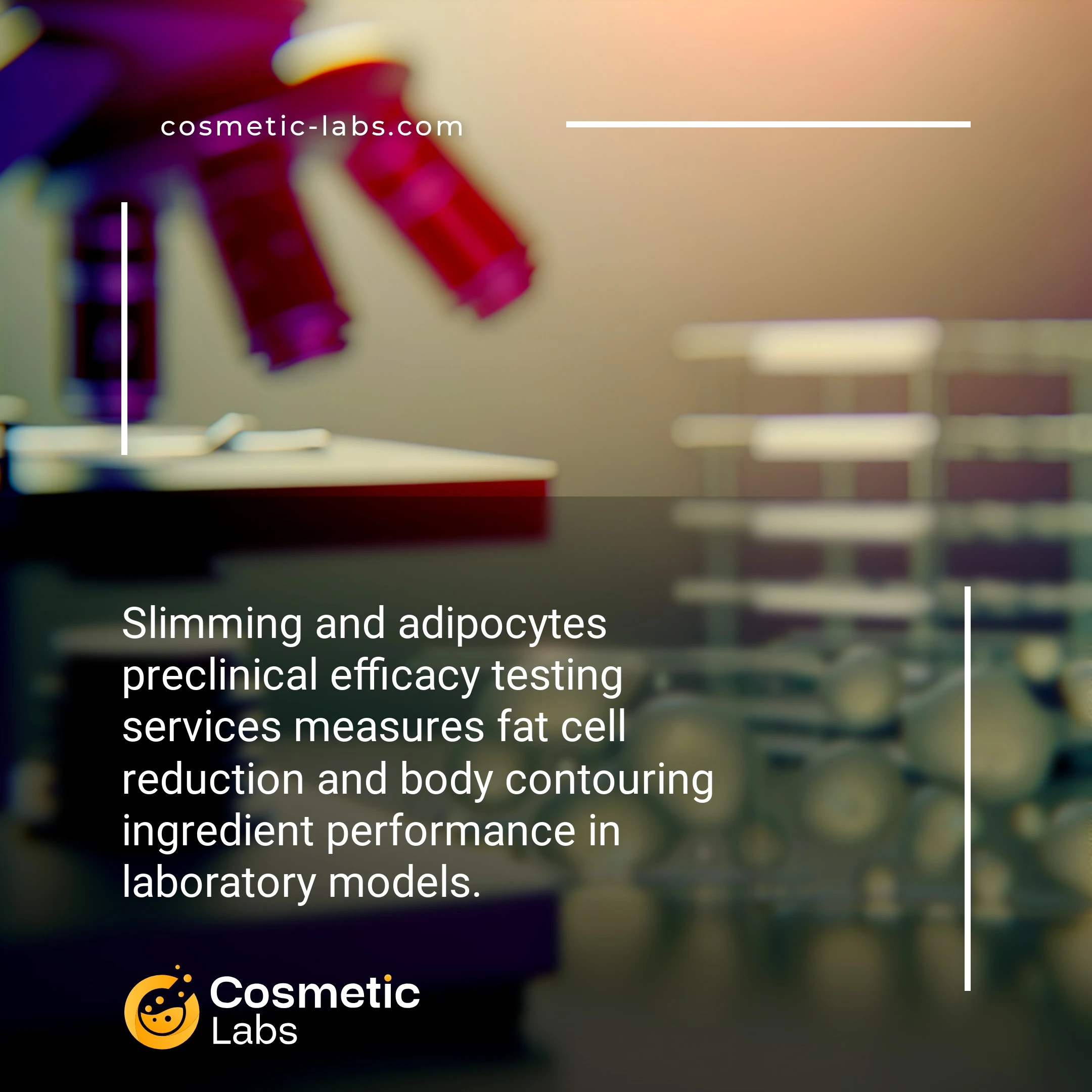Slimming Efficacy Testing for Adipocyte Research Services

What is Slimming and adipocytes efficacy testing?
Slimming and adipocyte preclinical efficacy testing services evaluate how cosmetic ingredients and formulations affect fat cells and body contouring before human trials. Labs use in vitro adipocyte cultures and lipolysis assays to measure fat breakdown, cell size reduction, and metabolic changes. These tests provide quantifiable data on ingredient performance—like caffeine’s ability to stimulate fat cell metabolism or peptides that inhibit lipogenesis—helping brands validate slimming claims with scientific evidence before market launch.
Why do you need this service?
Cosmetic labs use adipocyte differentiation assays and lipolysis measurements to validate your body contouring serums and slimming creams before market launch. These tests measure fat cell reduction, metabolic changes, and ingredient penetration in controlled laboratory conditions, giving you concrete efficacy data for regulatory submissions and marketing claims. Labs also apply these protocols to screen active ingredients during formulation development, helping you select the most effective compounds for your target demographics.
Who provides Slimming and adipocytes efficacy testing services?
All cosmetic labs providing Slimming and adipocytes efficacy testing services
There is no company providing these services at the moment.
Slimming and Adipocyte Preclinical Efficacy Testing Services
Cosmetic labs provide specialized slimming and adipocyte preclinical efficacy testing to validate body contouring and fat reduction claims before market launch. These services help brands demonstrate measurable results through controlled laboratory studies that examine how active ingredients interact with fat cells and surrounding tissue.
In Vitro Adipocyte Testing Methods
Labs use cultured adipocytes to test ingredient effects on fat cell metabolism and lipid storage. Cell viability assays measure how active compounds influence adipocyte differentiation and lipolysis rates. Testing protocols include:
- Glycerol release quantification to measure fat breakdown
- Oil Red O staining to visualize lipid accumulation changes
- MTT assays for cell metabolic activity assessment
- Gene expression analysis for adipogenesis markers
Results provide quantitative data on ingredient potency and optimal concentration ranges for formulation development.
Ex Vivo Tissue Testing Protocols
Labs conduct ex vivo skin penetration studies using dermatomed tissue samples to evaluate ingredient delivery through skin layers. These tests measure active compound distribution in subcutaneous fat tissue and dermal compartments.
- Franz diffusion cell studies track ingredient permeation rates
- Histological analysis reveals tissue morphology changes
- Biochemical assays quantify enzyme activity in treated samples
- Immunohistochemistry identifies cellular pathway activation
This testing approach bridges the gap between cellular studies and human trials, providing brands with robust efficacy data. Connect with specialized labs on our platform to discuss your slimming product testing requirements and regulatory compliance needs.
6 subcategories of Slimming and adipocytes efficacy testing services
There are no results matching your search
Practical Applications of Slimming and Adipocyte Preclinical Efficacy Testing
Cosmetic labs provide slimming and adipocyte preclinical efficacy testing services to validate body contouring claims before market launch, helping brands substantiate their product performance with scientific data.
Body Contouring Product Development
Labs test active ingredients like caffeine, forskolin, and carnitine using 3T3-L1 adipocyte cell models to measure fat cell volume reduction. These in vitro lipolysis assays quantify triglyceride release and monitor cellular morphology changes over 7-14 day treatment periods.
Testing protocols include MTT viability assays, Oil Red O staining for lipid quantification, and glycerol release measurements. Results show percentage reductions in lipid accumulation, typically ranging from 15-40% for effective formulations compared to untreated controls.
Anti-Cellulite Formulation Validation
Preclinical testing evaluates anti-cellulite ingredients through collagen synthesis assays and extracellular matrix remodeling studies. Labs use human dermal fibroblast cultures to assess collagen type I production and measure matrix metalloproteinase inhibition following ingredient exposure.
Testing includes elastin fiber analysis, hyaluronic acid quantification, and inflammatory marker assessment. Data demonstrates ingredient efficacy in improving skin firmness parameters, with typical results showing 20-35% increases in collagen production within 72-hour exposure periods.
| Test Method | Target Mechanism | Measurement Parameter | Typical Timeline |
|---|---|---|---|
| 3T3-L1 Differentiation Assay | Adipogenesis inhibition | Lipid droplet formation | 10-14 days |
| Glycerol Release Assay | Lipolysis stimulation | Free glycerol concentration | 24-48 hours |
| Collagen Synthesis Assay | Dermal structure support | Procollagen I C-peptide | 72 hours |
| MMP Activity Assay | Matrix degradation prevention | Enzyme activity inhibition | 4-6 hours |
Ready to validate your slimming formulation’s efficacy? Contact specialized cosmetic labs on our platform to discuss your preclinical testing requirements and timeline.

